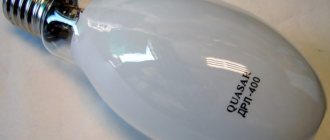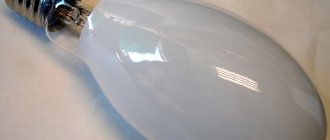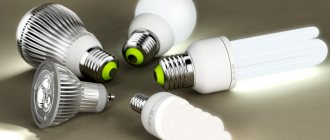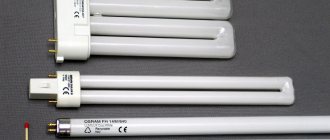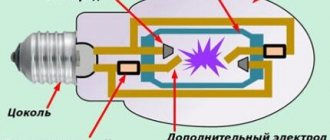The designs of the first lighting devices were quite primitive. They consisted of two electrodes, between which an arc discharge burned. These designs had two significant drawbacks: due to burnout, the electrodes needed constant adjustment, and the emission spectrum included a significant portion of ultraviolet radiation. Therefore, incandescent lamps, and later sodium lamps, very quickly occupied their niches in indoor and outdoor lighting.
To be fair, it must be said that even today these lighting devices still compete with brands of more economical LED lamps.
But there are areas where the use of sodium light bulbs will be a priority for a long time. Optimism is added by the high radiation flux in gas-discharge lamps, the long service life and high efficiency indicators of these devices.
What it is
One type of lighting is a sodium gas-discharge lamp (SL). This is an electric light bulb, the luminous elements of which are a gas discharge in sodium vapor. This allows you to get a bright yellow-orange light: it does not reproduce colors well, but copes well with street lighting in foggy conditions.
HPS lamp - high pressure sodium gas discharge lamp
Important! Sodium lamps are rarely used indoors, mainly where there are no requirements for good color rendering.
All sodium lamps are divided into:
- Low Pressure Sources (LPNS): Of all the LPs, they were the first to be created. They were common in Europe, where they are still used to illuminate country roads. The main differences between low-pressure lamps are the strong dependence of efficiency on ambient temperature and the production of the internal flask from borosilicate glass due to the high aggressiveness of sodium;
Light bulbs are divided depending on power and size
- High pressure luminaires (HPL): they are used for additional lighting of plants in industry. When creating it, it was necessary to solve two problems: how to neutralize the aggressive effect of sodium on glass and what to do with the high temperature of the electron arc. The tubes were made of aluminum oxide, the outer flask was made of heat-resistant glass. The burner is filled with gas mixtures and an alloy of sodium and mercury. There are also models without mercury.
High pressure lamps also come in several types:
- HPS: The acronym stands for Sodium Arc Tubular Lamp;
- DNaZ: Arc Sodium Mirror;
- DNaS: Arc Sodium in a Light Scattering Flask;
- DNaMT: Arc sodium Matt.
The DNaZ lamp is distinguished by a mirror surface.
It is important to note the following: in Europe and America, DNaT lamps are called “High-Pressure Sodium Lamp” or “HPSL”, translated as “High Pressure Sodium Lamps”. When these lamps appeared in the USSR, various factories began producing them: they were divided according to power, glass transparency, shape and other parameters. The most popular models have become DNAT models of various capacities.
In other words, DNaT is a conventional cylindrical low-pressure lamp, and DNa3 is a mirror-coated lamp.
Features of NLVD
The luminous flux, luminous efficiency and burning duration depend on the power of the NLVD. Color rendering is improved through the use of luminescent materials coupled with gas mixtures.
As for power , it must match the application. To illuminate seedlings, devices with parameters of 70-400 W are selected, which can serve in greenhouses in any season of the year.
Bulbs with higher ratings will simply burn the vegetables. Therefore, before purchasing them, be sure to consult with a specialist .
Advantages and disadvantages
HPS lamps have a large number of advantages, thanks to which they remain in demand today. Among its advantages:
- High level of light output compared to other light bulb models. High pressure lamps give up to 150-160 lm/W, low pressure lamps - up to 200 lm/W;
- Efficiency reaches 30%;
You may be interested in Features of spot lighting
The lamp produces a strong yellow light
- A wide range of temperatures at which the light bulbs operate: from −60 to +40 degrees. In this case, the lamp lights up even at low temperatures;
- Long period of operation: minimum period - 10-12 thousand hours, maximum - up to 30-32 thousand;
- Cost-effective: HPS consumes 1.5-2 times less electricity. The production of lamps is also inexpensive: it has been established for a long time and works well, expensive materials are not required;
- Anti-fog effect: yellow and orange colors are poorly absorbed by water, and therefore lamps with such lighting are better visible in rain and fog.
However, the disadvantages of DNAT are no less significant:
- Weak color rendering: all lamps have a pronounced yellow or orange color. Lamps cannot be used in residential premises;
- Long burn-up: the first 5-10 minutes the lamp burns weakly while it warms up;
The light bulb contains mercury, which makes it dangerous.
- Certain electrical requirements. Lamps can only be used in networks with a fairly stable voltage;
Important! The second option is to use high-quality chokes.
- Presence of mercury: for disposal, lamps must be taken to a special collection point. A broken lamp can be dangerous if removed incorrectly or not thoroughly;
- Temperature: despite the fact that HPS lamps can operate at −60 degrees, the optimal temperature for them is from −20 to +30 degrees. At higher or lower temperatures, the light output will be lower and the service life will be reduced;
- The presence of quite strong ripples, they can reach 50 Hz. This results in constant flickering, which is tiring for the eyes.
Safety regulations
Since the sodium source gets very hot during operation, certain rules must be followed. Thus, it is not recommended to touch the light source for 10 minutes after the lamp has been turned off. Also, do not touch the light bulb with your bare hands, as this will leave grease. When heated, it will turn into a dark spot and damage the case.
The penultimate rule concerns the need to provide ventilation to the light source, since it needs to be cooled. It is also worth placing the lamp at a great distance from fire hazardous objects. The last rule is that it is imperative to protect the light source from impacts, since due to its explosion, fragments will fly off over a long period.
Note! If the burner is damaged, the room will be filled with mercury and will need to be disinfected.
It is worth pointing out that sometimes the lamp goes out due to the fact that it has a poor contact or a voltage surge occurs with an interturn short circuit and a violation of the coil insulation. To correct the problem, the ballast must be replaced. If a new light starts blinking, then the problem is that the device is not warming up sufficiently. Sometimes there is a crackling sound and the source stops igniting. In this case, the wire that goes from the source to the ignition device breaks, and it is necessary to check the wiring and strip the contacts. When performing all of these actions, you must follow simple safety rules.
You might be interested in: Features of a fluorescent lamp
Carrying out work with rubber gloves as a guarantee of safety when connecting lighting equipment
Types of lamps
There are 2 types of HPS lamps - low and high pressure. They differ from each other in some characteristics.
The sodium light bulb takes several minutes to “warm up”
High pressure
These lamps are suitable for lighting industrial complexes, gyms and commercial facilities. They have better color reproduction, but some colors may appear duller than usual.
Low pressure
They are reliable in operation, consume little energy and have high light output for a long time. They are well suited for street lighting because they distort colors in enclosed spaces.
Flaws
There are certainly disadvantages to such lamps.
- luminous flux drops slightly after 15,000 hours of continuous operation
- cumbersome control circuit
- at the end of its service life, the color of the glow begins to change
The change goes from yellow towards orange with redness or even completely red.
- many are also not satisfied with the long startup process - up to 10 minutes
- the throttle itself emits a constant hum after prolonged operation
Technical specifications
Several types of HPS lamps of different powers are available: 70 W, 100, 150, 250 and 400. Below are the characteristics for 70 W and 400 W lamps:
- Lamp length: 16.5 cm and 27.8 cm;
- Diameter: 4.2 cm and 4.8 cm;
- Power: 70 W and 400 W;
- Luminous flux: 6 thousand lm and 45 thousand lm;
- Luminous efficacy: 66 lm/W and 88 lm/W;
- Power consumption: 90 W and 510 W;
- Lamp voltage: 90 V and 100 V;
- Service life: 14 thousand hours and 18 thousand hours.
You may be interested in How to determine the lighting in an apartment
Operating principle
For an electric charge to occur in a gaseous medium, a high voltage pulse is required. Since sodium melts at a fairly high temperature, the electric charge ignites slowly: low-power HPS produces a full luminous flux after 5-6 minutes, and high power - after 10-15 minutes.
At the moment of startup, the environment is cold, its electrical resistance is low, so the process is accompanied by an avalanche-like increase in current in the circuit, which can cause overheating and destruction of the lamp electrodes. Therefore, the DNAT control gear includes an electronic ballast (choke) - an inductor without a core. Compensation occurs due to the emergence of a magnetic flux directed opposite to the current that generated it.
Principle of operation
The inside of the flask is filled with a mixture of gases and contains an aluminum oxide burner. This is where all the work of the lamp takes place.
The connection principle is shown in the diagram
The sodium lamp has a simple design and simple principle.
- After switching on, the built-in ignition device begins to generate pulses;
- An arcing electronic charge is formed in sodium vapor, which causes the vapor to begin to glow. The light comes on;
- The burner gradually warms up and the light becomes brighter;
- In modern lamps, a choke is built into the design, which limits the arc current and ensures an uninterrupted supply of current.
Disposal
Disposal of devices
Sodium is a volatile substance that ignites easily when exposed to air. In addition, the elements contain mercury, a dangerous radioactive element that can cause severe poisoning. For this reason, it is unacceptable to simply throw away sodium lighting sources. They must be disposed of as potentially hazardous waste along with other energy-saving lamps.
In large cities, recycling bins are provided. If this is not possible, contact your nearest lighting repair shop, manufacturing facility, or hazardous waste collection service.
What does it consist of?
The device is a flask made of special high-strength aluminum oxide, which can withstand both high temperatures and the action of sodium vapor. 2 electrodes are attached to the edges of the flask; the flask itself is filled with a mixture of inert gases, an alloy of mercury and sodium, and xenon.
DNAT has a simple device
The burner is housed in a smaller flask made of heat-resistant glass, usually borosilicate glass. A vacuum is created in the flask and supplied with a base through which the connection to electricity will be made.
In other words, it turns out to be a flask within a flask: in the center of the large outer one there is a small cylindrical flask with a burner inside. The outer flask acts as a thermos, protecting the burners from low temperatures, increasing efficiency and reducing heat loss.
Base
Through it, the lamp is connected to the electrical network. The most commonly used screw connection is type E (Edison) - E27 for DNAT 70 and 100, and E40 for DNAT 150, 250 and 400. The numbers on the marking indicate the diameter in millimeters: for example, E40 is a base with a diameter of 40 mm.
Burner
This is an important part of any HPS light bulb. It is a thin glass cylinder that is resistant to high temperatures and chemical reactions. It has tungsten electrodes inserted on both sides.
The light bulb consists of 2 bulbs - one placed inside the other
During its manufacture, deep vacuumization is carried out, that is, absolutely all the air and oxygen are pumped out. This is an important safety requirement: the base heats up to 1300 degrees, and if oxygen enters, the lamp can explode.
Device
Structurally, a HPS sodium lamp is very similar to other gas-discharge devices. It looks like a glass flask in the shape of a cylinder with a base.
Structure of DNAT:
- The outer casing is made of heat-resistant durable glass.
- A discharge tube in which an arc is formed.
- Electrodes.
- Ceramic plug.
- A niobium rod that communicates with the internal cavity of the burner.
- Barium rod that absorbs gas.
- Screw base.
Inside the flask there is a burner, along the edges of which there are electrode elements. The aluminum oxide from which the discharge tube is made makes it resistant to sodium vapor. It transmits about 90% of light.
There are gaskets inside the case that prevent air from entering it. The temperature in the burner can reach about 1300°, if oxygen gets into it, the light bulb can crack or explode. This is precisely what the gaskets protect from, maintaining a vacuum inside the flask.
Area of use
HPS light sources are not used in residential areas due to excessive power and distorted color rendering: for example, green often “turns” into black or dark blue. However, light bulbs have found application in other areas:
- Lighting of streets and roads. The lamps performed especially well when working in foggy areas;
- Underpasses, railway stations and airports, parking lots, tunnels;
The lamps work well even in fog and rain
- Industrial premises, warehouses, workshops, parking lots, sports complexes, for which the correct transmission of light is not important;
- Illumination of monuments and buildings;
- For greenhouses, flower beds and other complexes in which plants are grown. This allows you to grow plants all year round, regardless of the season.
You might be interested in this All about the DRL 125 light bulb
In greenhouses they use lamps with a power of 150-250 W; a 400 W lamp is also suitable, but it will need to be placed further away. For the street, lamps with a power of 70-150 W are required.
Important! For street lighting, it is important to choose lamps that are protected from moisture and dust.
Classification of street lamps depending on design
Methodology for calculating lighting in domestic and industrial premises
Street lamps are structurally different, which is caused by the installation features.
Street ground lamps are represented by three types of devices.
- Reflector lights: illuminate highways and major highways. The light flux from a 250-400 W lamp is focused and converted into a directional one.
- Lamps with diffused lighting: used for equipment on secondary highways. The lamp power is selected within the range of 70-250 W.
- Forged street lamps with diffused lighting: the lampshade can be cylindrical or spherical. Lamp power – 40-125 W. Pedestrian areas (paths, sidewalks, squares) are equipped with such lamps. A variety of them can be pendant street lamps. A lantern of complex shape may have a cantilever fastener.
In addition to ground-based ones, there are street lighting lamps of other designs.
- Facade lamps are most often spotlights. They are mounted on walls, installed on parapets and directly on the ground. The latter are used to equip stairs and garden paths.
- Street ceiling lamps are mounted above the porch of entrances, in the halls of open-type stations. Another option is outdoor recessed lights.
- A street lamp suspension can decorate the front porch.
- The built-in waterproof device is used to illuminate fountains.
When choosing an outdoor lighting lamp, it is necessary to take into account not only its main characteristics. The device must be organically combined with the architectural style of the building. And it is desirable that it be inexpensive.
How to connect a lamp correctly
It will not be possible to connect the light bulb to a regular household network, since the available voltage is not enough to operate it. In addition, it is necessary to limit the arc current so that work proceeds without interruption.
Important! All sodium lamps, both HPS and HPS, are connected according to the same circuit.
To connect the lamp you need the following elements:
- IZU is a Pulse Ignition Device that helps increase the voltage in the network until an arc forms. IZUs can be 2-pin and 3-pin: the former are cheaper and simpler, the latter perform better in operation. When connecting a two-terminal IZU, when turned on, the discharge is applied to the lamp and ballast, when connecting a three-terminal IZU - only to the lamp;
To connect you will need several additional elements
- A ballast is an electronic or electromagnetic ballast that limits the current after starting. Electronic ballast or electronic ballast is an electronic circuit, electromagnetic is a choke (a coil with an open magnetic circuit). When connecting, the inductor must be connected in series with the DNAT, and the IZU in parallel.
The connection diagram for a two-pin IZU occurs in several steps:
- The IZU is connected in parallel with the lamp;
- The “phase” wire after the inductor must be connected to the desired terminal of the IZU;
- The second tip is connected to the remaining clamps.
A three-terminal IZU requires a longer connection.
The connection diagram for a high-pressure sodium lamp and a three-terminal IZU is a little more complicated:
- One negative wire must be connected to the light bulb, the second to the same type of IZU terminal;
- Next, you need to open the phase and connect one cable from the panel to the inductor;
- The middle conductor is connected to the light bulb.
When connecting a HPS lamp, you must use the diagrams. If in doubt, it is better to contact a specialist rather than connect it yourself.
Precautionary measures
When using sodium discharge lamps, it is important to remember:
- It is unacceptable to turn off the power to the element immediately after it has been turned on. You need to wait at least 1-2 minutes. Failure to comply with this recommendation may result in complete startup failure.
- The room with the lighting element must have a ventilation system. This is due to the increased heat transfer of the device and the presence of harmful substances in it.
- Do not touch the lamp or reflector with bare hands during operation as this will cause serious burns.
- It is advisable to use gloves when installing the flask. Fatty deposits when heated can cause the flask to explode. It is prohibited for water to enter open elements.
- The ballast used together with the light bulb can heat up to temperatures of about 150 degrees. It is recommended to place it under a fireproof casing to protect it from moisture and debris.
- Do not touch conductive elements with bare hands or allow them to get wet. It is also recommended to periodically check the wiring for damage, burns or short circuits. In this case, the wires must be special, designed to work with extremely high voltages.
Life time
The service life of DNAT lamps is quite significant: the minimum life is 14 thousand hours (more than 1.5 years), the maximum is up to 32 thousand (more than 3.5 years). In this case, the duration of operation depends on external conditions (if the temperature is too low, wear will be greater), voltage in the electrical network and other nuances.
Light bulbs can be used as additional lighting for greenhouses
HPS lamps are high-pressure sodium lamps that have not lost their popularity. They are characterized by a long service life, low cost and high luminous efficiency. Despite a number of disadvantages (the main one being poor color reproduction), lamps of this type are still used for street lighting.
Recommendations for selection
For specific use, lamps are selected according to the type of installation solution (column, floor lamp, string, wall). The problem of obtaining the required illumination (in lux) is solved by the power of the lamp, the type of reflector (reflective or white flat) or diffusing element. The color of the flow can be changed by the color temperature of the lamp or by selecting a filter in the lampshade.
It is also important that the style of the lamp matches the architecture of the house. Thus, a stylish minimalist lamp fits well into the facade of a modern building with a flat roof and rectangular architecture, while lamps reminiscent of antique gas lanterns are more suitable for a classically shaped house.
When choosing a lamp, one should not forget about economics: street lamps should consume the minimum possible amount of energy. Automation should help with this, switching the maximum flow rate to average, minimum and zero according to the selected program, photo relay or timer.
Domestic products
Russian Reflex lamps, which are equipped with a built-in reflector, are in great demand on the market. Due to this, the light is directed directly at the plants. The reflector of Reflux lamps has a high efficiency of 95%, which is maintained throughout the entire period of operation. Typically, one Reflax lamp with a power of 70 Watt, suspended at a height of half a meter, is capable of illuminating an area of about 1.6 m2. And since the use of other light sources implies high energy costs, the use of Reflux lamps is more rational. As for the dimensions, Reflax has dimensions of 76x200 mm. Thanks to this, Reflex lamps are best suited for greenhouse owners.
Throttle
Regarding the quality of chokes and why they fail in new lamps.
Modern compact ballast chokes are mostly made by winding one coil in bulk, without interlayer insulating spacers. Plus, they are somehow impregnated with varnish, without protecting the winding with a protective compound.
If moisture gets into the case with the circuit, you'll be in trouble. Soviet large chokes were wound only with a two-rod, two-spool design, each of which had interlayer cardboard insulation.
Hence their practically eternity. But modern marketers and manufacturers, unfortunately, are not interested in this.


